Bahcesehir University (BAU) (Bahçeşehir University) systematically monitors, tracks, and evaluates access to higher education through comprehensive gender-disaggregated data collection and analysis across all admission pathways. This process allows the University to ensure fairness, transparency, and equal opportunity in every stage of admission and scholarship allocation.
1- For Turkish Students:
Bahcesehir University’s central admissions office continuously tracks and reports the application and acceptance rates of female students within national admissions, identifying trends and disparities in access across disciplines. The data are reviewed annually to assess representation and inform targeted outreach and mentoring initiatives that encourage women’s participation in all academic fields.
For Turkish students, female applicants have consistently represented the majority throughout the four-year period. In 2021, female applications accounted for approximately 61%, increasing slightly to 62% in 2022, then experiencing a minor decrease to 59% in 2023 before recovering to 63% in 2024. Female enrollment rates followed a similar but slightly lower pattern, rising from 54% in 2021 to 56% in 2022, maintaining near 55% in both 2023 and 2024. In contrast, male applicants comprised 39% in 2021 and remained relatively stable over the years, with slight variations between 38% and 41%, ultimately returning to 37% in 2024. Male enrollment rates fluctuated between 44% and 46% during the same period.
A visual summary of these findings is provided in the graph below, highlighting the consistent predominance of female applicants and enrollees across both student groups during the 2021–2024 period:
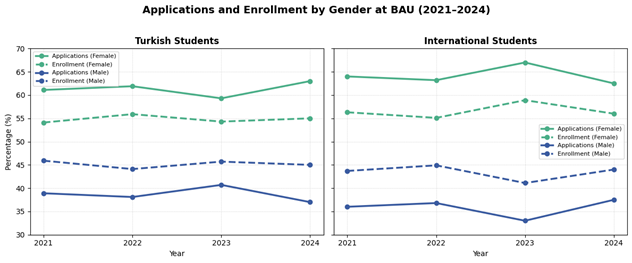
33.3%. The Department of Physiotherapy and Rehabilitation demonstrates an equal gender balance, with both female and male students representing 50.0% each.
At the Faculty of Engineering and Natural Sciences, the Department of Industrial Engineering records 58.3% female enrollment and 41.7% male enrollment.
In the Faculty of Economics, Administrative and Social Sciences, the Department of Psychology shows a high female majority, with 93.3% female students and only 6.7%. In the Faculty of Communication, the Department of Advertising reflects 46.2% female students and 53.8% male students.
These statistics underscore Bahçeşehir University’s ongoing commitment to systematic gender data collection and evidence-based policy development. By continuously analyzing gender representation across disciplines, the University aims to enhance inclusivity, address gender disparities, and promote equitable participation in all academic areas.
These trends are visually represented in the images below, highlighting the diversity of gender balance across programs for the 2024 academic year.
PS: “Yerleşenlerin Cinsiyet Dağılımı” means Gender Breakdown of Placed Students / “Kız”: Female / “Erkek”: Male
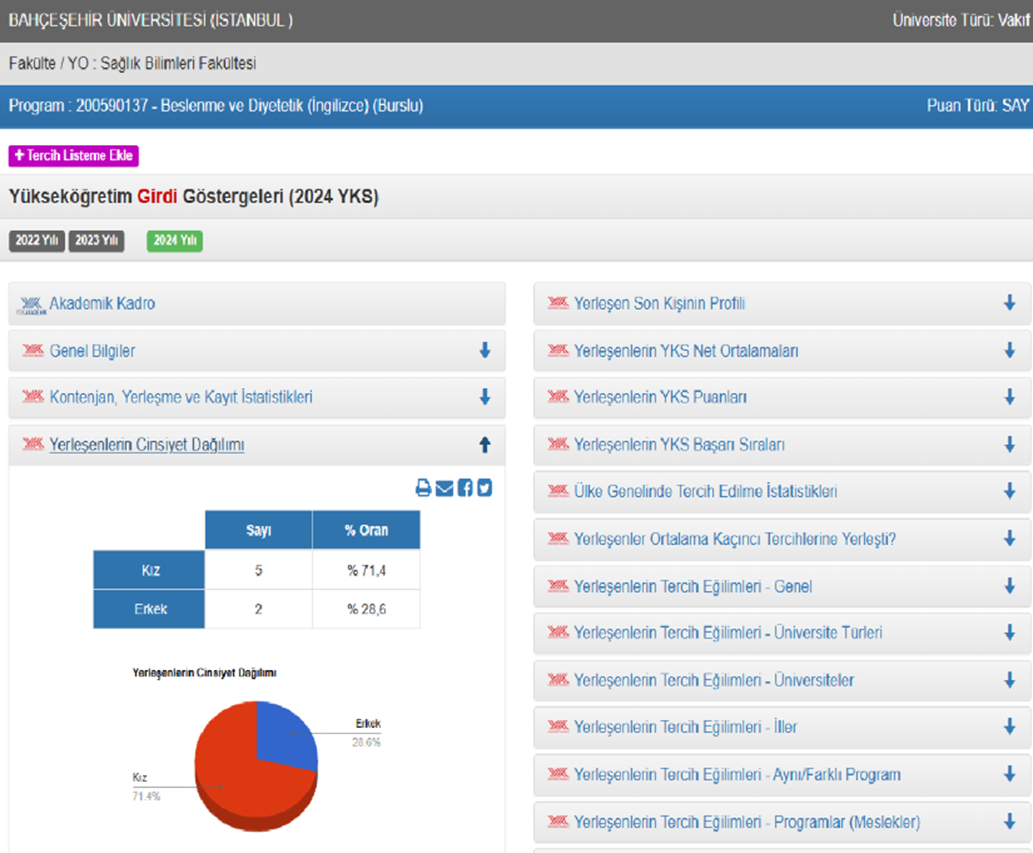
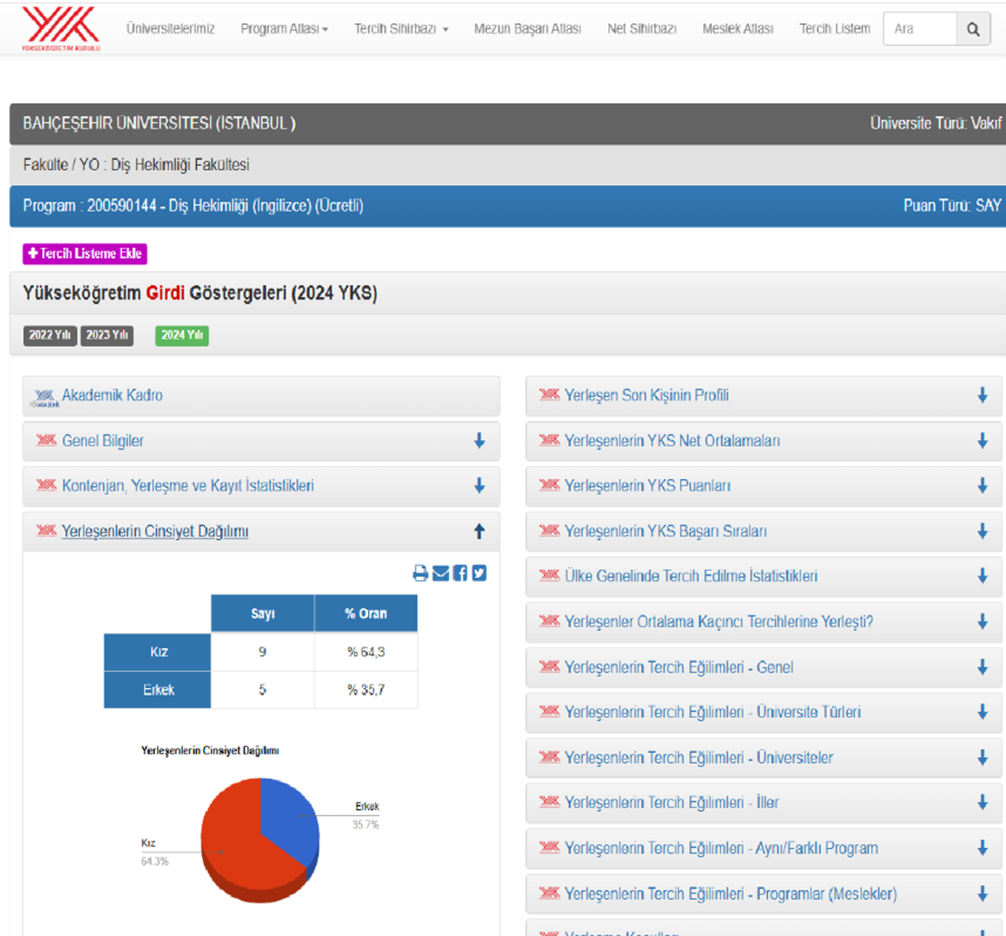
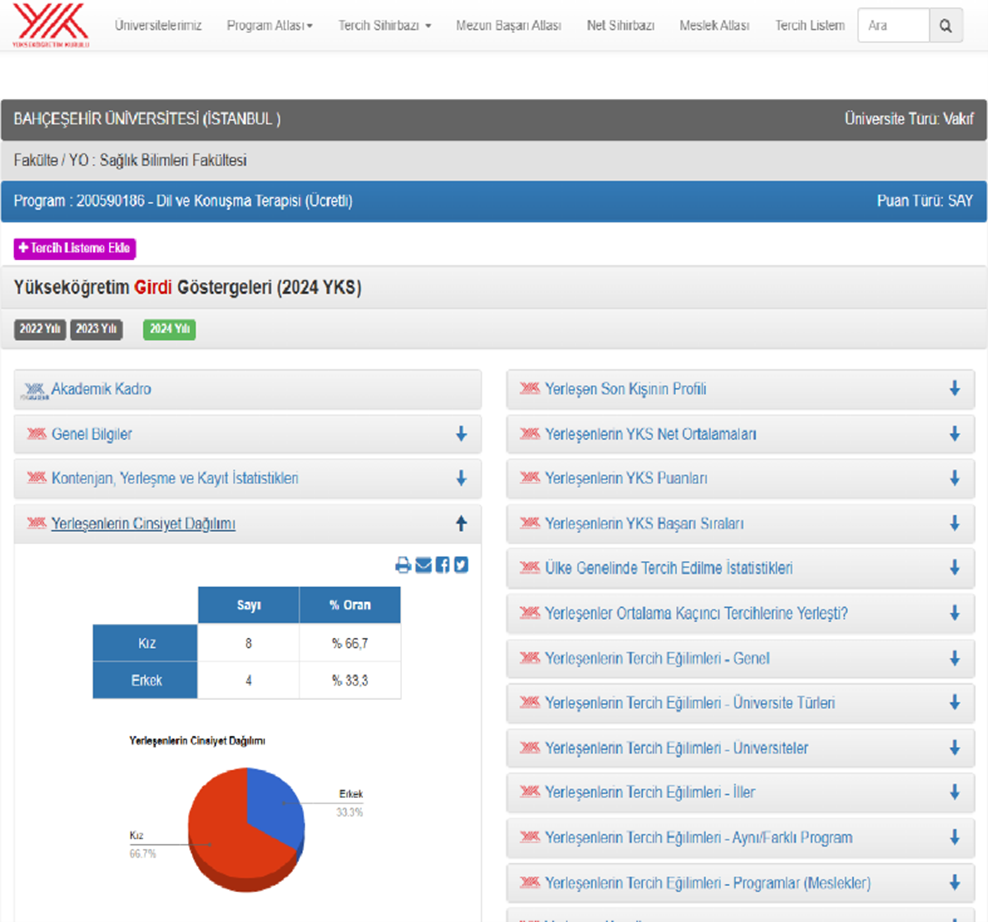
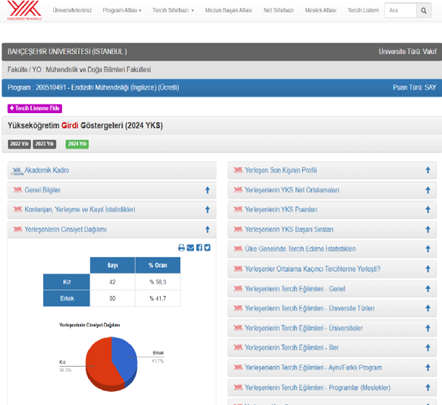
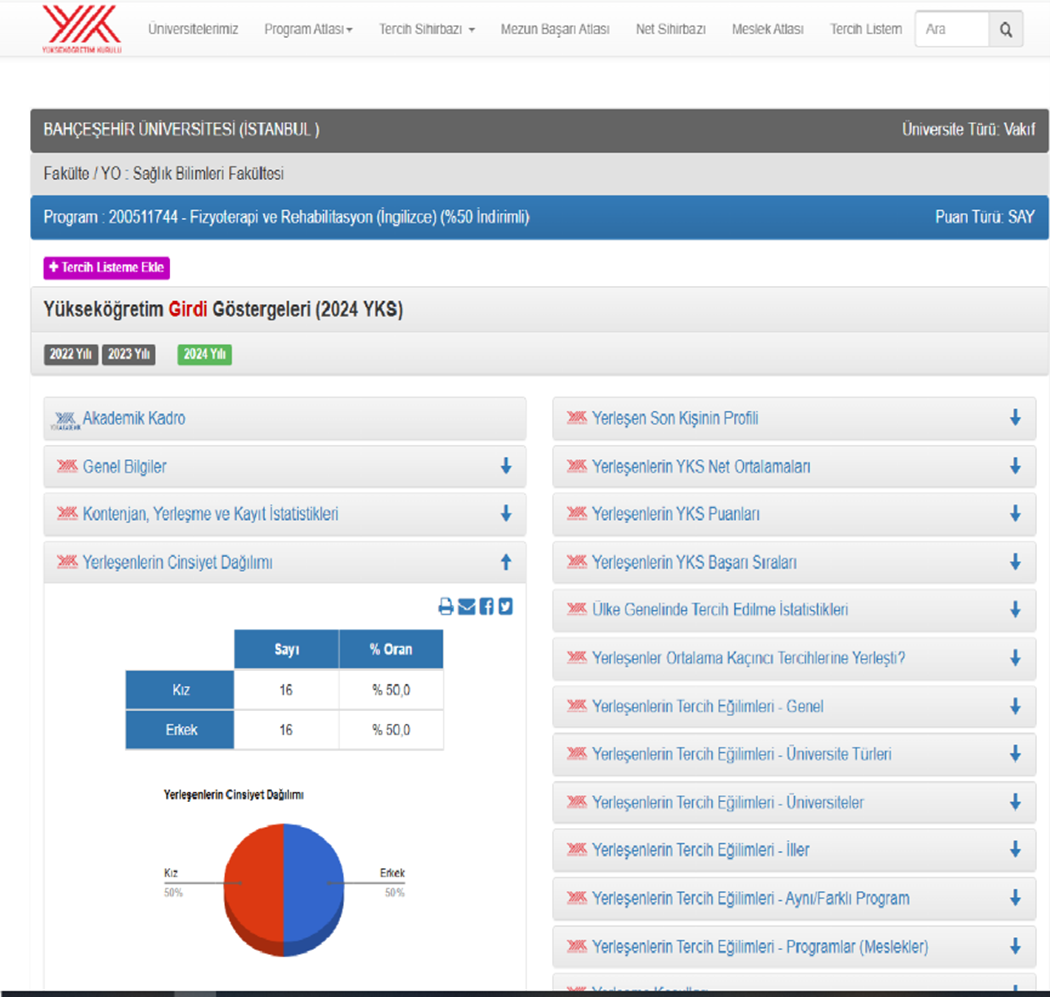
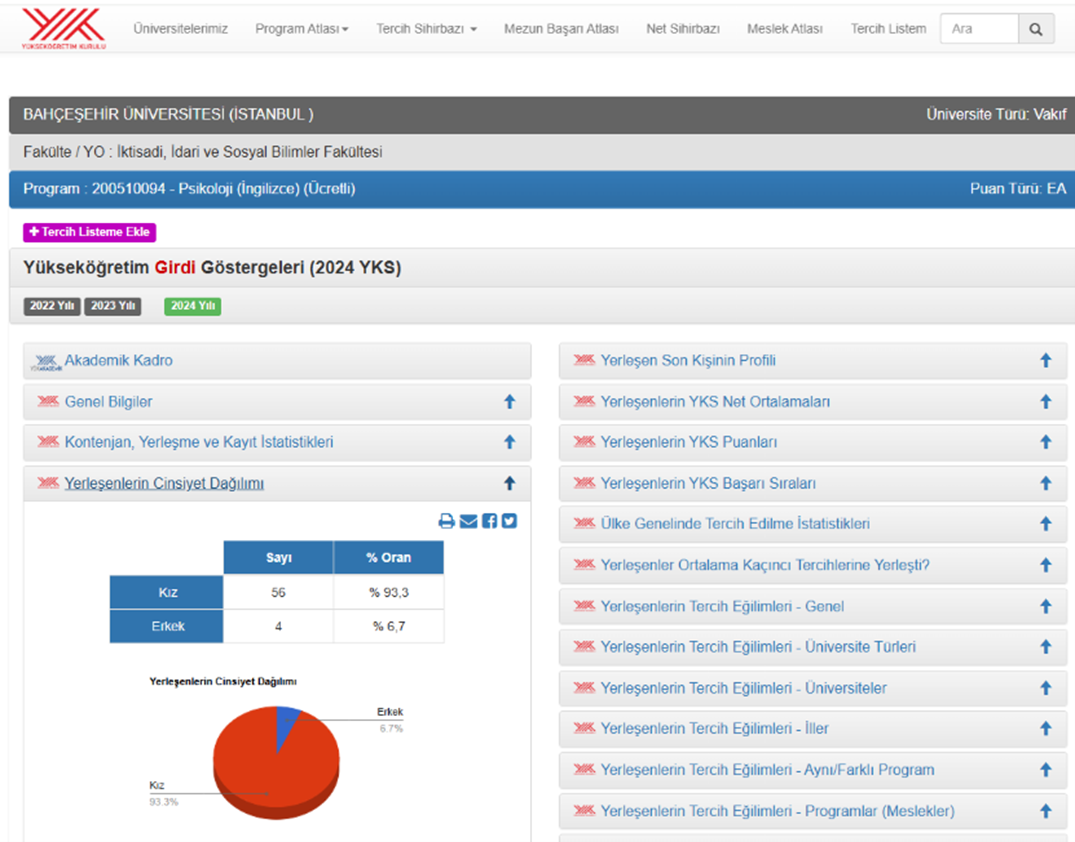

2- For Turkish Students Applying through the ApplyBAU Scholarship System:
Through the ApplyBAU digital platform, Bahçeşehir University systematically monitors gender representation across faculties to ensure that both application and scholarship processes support gender equality. Between 2021 and 2024, the University has consistently tracked female applicants’ scholarship application and award success rates, using this data to inform evidence-based revisions to admission and financial aid policies.
The data reveal that female students continue to constitute the majority of scholarship recipients in several faculties. In the Faculty of Educational Sciences, women account for approximately 80% of all scholarships awarded by 2024, indicating strong and consistent female participation. Similarly, the Faculties of Health Sciences and Architecture and Design have maintained high female representation—ranging between 70% and 85%—demonstrating sustained gender balance in traditionally female-oriented disciplines.
Faculties such as Engineering and Natural Sciences and Law have exhibited more dynamic trends. The proportion of scholarships awarded to female students in these areas has progressively increased over the four-year period, with notable improvements particularly in Law, where the percentage rose from around 40% in 2021 to 60% in 2024. The Faculties of Applied Sciences, Economics, Administrative and Social Sciences, and Communication show stable gender parity, with scholarships distributed almost equally between male and female students.
These outcomes confirm that BAU’s institutional policies and the ApplyBAU platform have jointly contributed to strengthening female participation and equitable scholarship access. The data are visually represented in graphs below, which illustrate gender distribution trends in scholarship awards by faculty between 2021 and 2024.
The graphs below present the monitoring reports of the relevant statistics by year.

3- For International Students:
BAU also tracks the participation and success of female international applicants, monitoring gender ratios in application, acceptance, and enrollment rates. These data support BAU’s efforts to eliminate gender-based barriers in global recruitment and strengthen women’s access to internationally accredited, inclusive education opportunities.
For international students, female representation has been even more prominent. Female applications made up 65% in 2021, maintained 64% in 2022, peaked at 67% in 2023, and slightly declined to 63% in 2024. Female enrollment rates followed a closely aligned trend—57% in 2021, a small dip to 55% in 2022, an increase to 59% in 2023, and a return to 56% in 2024. Meanwhile, male applications ranged between 33% and 37%, reaching their lowest point in 2023. Male enrollment rates also remained steady, varying narrowly from 41% to 45%.
4- For Graduate Students:
BAU systematically tracks access measures for graduate-level education to ensure gender equality and inclusiveness across all programs. The university monitors gender representation in applications, admissions, and enrollments, aiming to maintain equitable access to advanced study opportunities for both women and men.
The data covering the 2023 and 2024 academic years indicate that female students’ numbers consistently constitute the majority among graduate enrollees.
Percentage trends confirm this gender distribution pattern, with female representation rising to 58% in Fall 2023–2024.
These findings demonstrate BAU’s ongoing efforts to promote equitable participation and inclusiveness in postgraduate education. The graph below presents the corresponding numerical and percentage distributions, based on the University’s graduate student access monitoring results.
The graphs below present the monitoring reports of the relevant statistics by year.

Additionally, BAU tracks the implementation and impact of targeted scholarships and financial support programs for female graduate students. These scholarships are designed to promote women’s participation in research, innovation, and leadership. Through regular monitoring and evaluation, BAU ensures that these initiatives effectively contribute to strengthening women’s representation in postgraduate education and reinforce the university’s ongoing commitment to equality, inclusion, and academic excellence.
The proportion of female scholarship recipients has consistently surpassed that of male recipients.
Across the two academic years, the overall distribution indicates that 58.6% of scholarships were awarded to female students, while 41.4% were granted to male students. This consistent gender balance reinforces Bahcesehir University’s commitment to equitable funding policies and gender-sensitive approaches to postgraduate education. The graph below illustrates the percentage distribution of scholarships by gender, based on the University’s graduate access monitoring results.
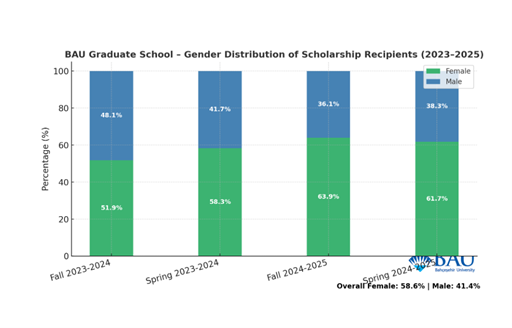
All results are publicly reported through institutional equality and admissions reports, reflecting BAU’s dedication to data-driven, transparent, and inclusive admissions practices that advance gender equality and equitable access for all learners.